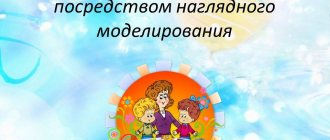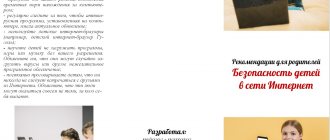Summary of a non-traditional parent meeting in the 2nd junior group with presentation
Synopsis of a non-traditional parent meeting “Features of speech development in children of primary preschool age”
Author: Muravyova Marina Vladimirovna Place of work: MADOU “Kindergarten No. 51 of general developmental type” Syktyvkar, Komi Republic.
Purpose: Intended for holding a parent meeting in the second junior group of kindergarten. Conducted in the form of a presentation. Goal: enriching parental ideas about the speech development of children of primary preschool age. Objectives : 1. show parents the results of working with children on speech development through theatrical activities (final event for the project activity “Fairytale Theater”); 2. introduce the analysis of the survey “Do you know your child’s favorite fairy tale?”; provide information about the importance of fiction in child development. 3. developing the pedagogical competence of parents in speech development through familiarization with didactic games that promote the speech development of children 3–4 years old (presentation); 4. intensify teaching experience on the topic of the meeting; 5. strengthen cooperation between the family and the teaching staff. Preliminary work: 1. Announcement of the meeting. 2. Questioning parents “Do you know your child’s favorite fairy tale?” 3. Creation of a presentation “Workshop for parents of the second junior group. Speech development in children 3-4 years old. Didactic games." 4. Creating a presentation “Analysis of the survey “Do you know your child’s favorite fairy tale?” Advice for parents." 5. Design of booklets “Didactic games for speech development with children 3-4 years old.” 6. Making invitations to a parent meeting for each family together with the children. Proceedings of the meeting: Good evening, dear parents!
We are glad to meet you. Thank you for taking the time to come to the parent meeting. Today on the agenda: 1. Presentation of a workshop for parents on speech development; 2. Presentation of the survey “Do you know your child’s favorite fairy tale?”, recommendations for reading fiction; 3. Final joint event for the project activity “Fairy Tale Theater” - children’s performance; 4. Tea drinking (talking about different things). I. The introductory part to the collection is the presentation of a workshop on didactic games on speech development for children 3-4 years old “Speech development in children 3-4 years old.” Informing parents about methods for activating a child’s speech activity and the importance of parental participation in this matter. Distribution of booklets “Didactic games for speech development for children 3-4 years old.” This will serve as a means of developing parents’ pedagogical competence in speech development, concentrating their attention and showing interest. slide 1. Main tasks of speech development. slide 2. Formation of a dictionary. Active dictionary. slide 3-4. speech contains nouns, verbs, pronouns (my, yours, ours), adverbs (here, there, here), numerals (one, two), possessive adjectives (uncle’s hat, mother’s coat). generalizing concepts (wild animals, domestic animals, their young; fruits, vegetables; toys, dishes.) slide 5-6. Grammatical structure: answer questions from adults with detailed phrases consisting of 3-4 or more words. prepositions in speech “In”, “On”, “Under”, “Above”. Sound pronunciation: slide 7-8 all whistlers pronounce (s, s, з, з, у) all labials (p, p, b, b) all dental (t, t, d, d) labiodental (f, f, в, вь) all vowels (а, о, у, ы, и, iotated я, ю, е, ю, е) hissing (ш,ж,ч,ш) replacements with whistling porridge - “kasa” - sonorant (р , рь, l, l) are replaced by [l], less often (th) – yabota, yeka. slide 7-8. Advice from a speech therapist: adult speech: clear, unhurried, grammatically and phonetically correct, words should not be distorted, or imitate children’s speech; draw children’s attention to how they coordinate words in a sentence, correct the child (correct mistakes); while playing with a child, practice coordinating nouns with different parts of speech, for example, with verbs: take a doll and ask: “Who came to visit us?”, and the child gives the full answer: “A doll came to visit us”; use the game “What’s missing?” them. noun in p.p. units (stage 3-4 games, etc.) - use a toy to teach prepositions; teach the child to independently describe the toy. Put the toy down, look, then ask questions: What is this? or who is it? What colour? What is this from the bunny? (point to ears, tail, paws) What can you call a bunny? teach children to compare objects and find commonalities; What is the difference? teach how to select words for certain verbs: the dog is running, who else can run, etc. slide 9-10. Articulatory gymnastics: is a set of special exercises aimed at strengthening the muscles of the articulatory apparatus, developing strength, mobility and differentiation of movements of organs involved in the speech process. Articulation gymnastics is performed with children in a playful way in front of a mirror for 5-10 minutes. I bring to your attention several exercises: For the lips: “Smile” “Fence” hold, counting to 5 “Proboscis” “Tube” slide 12. For the tongue: “Blink” slide 11. Massage. 1). “Bite your tongue” 2). “The tongue is pulled out, but the teeth are trying to hold on” 3). Relax the tongue “Punish a naughty tongue” 2. Development of the prosodic part of speech: voice, breathing, tempo, rhythm, speech hearing. slide 12. Speech hearing is very important in a child’s mastery of speech. Hearing words, the baby begins to pronounce them himself. Recording the game “Echo” - voice, intonation, exhalation force. II. Then a presentation on the “Questionnaire “Do you know your child’s favorite fairy tale?”, advice to parents on reading Russian folk tales. 1 slide. Does your child like reading? Does he listen carefully when you read to him? Advice: read EXPRESSIVELY, with intonation, make imitative movements - children really like it. For example, the grandfather beat the testicle - knocking his fist on his fist. The fairy tale should be understandable to children. When reading a fairy tale to children, answer their questions, replace unfamiliar words with familiar ones or explain their meaning (for example, lighthouse, rocker, etc.). 2 slide. Do you take into account the age of the child and look at the contents of the book when purchasing? Advice: before reading a fairy tale to your children, read it yourself from beginning to end. Firstly, you will decide whether it is worth spending time reading a fairy tale to your child if you didn’t like it. Secondly, some fairy tales may contain scary or unpleasant moments, especially when it comes to modern versions of famous fairy tales. By listening to this advice, you will not read a bedtime story to your children about death or severed heads. Read age-appropriate stories to children. Only then will they be useful and interesting to kids. 3 slide. Does your child have his own bookshelf or corner with books? Advice: many parents who instilled in their child a love of reading have their own tricks. “In the children's room, all the toys are hidden in cabinets. When the son doesn’t see any toys, he reaches for the open shelf where there are books with bright covers. And in the living room there are “adult” books on open shelves. When my son asks if he can borrow a novel, I answer that in a few years, when he grows up, he will be able to read it,” said Anna, the mother of two children. This technique can only work well if parents choose books with diligence and responsibility. The shelves should not be filled with comics, but with fascinating and instructive publications. 4 slide. Do you often read books to your child? The child’s brain is designed in such a way that first he remembers information, learns it from memory, and then understanding and awareness of this information comes. As a rule, a fairy tale contains a chain of events, but it seems to us, adults, that everything is presented in an accessible way in the book. But in reality, it is difficult for a child to digest the entire fairy tale in one listen, so there is a need to listen to it and listen. In addition, the child has a need for stability and rituals. He has already listened to the fairy tale, remembers the ending, and thus the child develops a feeling of confidence, protection, he has, as it were, protected himself from unexpected events. And, of course, there is no need to fight this, but rather, on the contrary, with all actions to support the child’s attachment to a specific fairy tale. 5 slide. Please name your child’s favorite fairy tales? Advice: read your children their favorite fairy tales more often, even if you are tired of them. Every child has a favorite fairy tale. Children are ready to listen to such a fairy tale again and again, worrying about its heroes each time, because they identify themselves with them. If you understand why your baby loves this particular fairy tale, then you will better understand his inner world. If suddenly your child does not like fairy tales, choose a fairy tale based on the plot of his favorite cartoon (for example, Disney). 6 slide. Do you talk with your child about what you read, do you evaluate the actions of the characters? Tip: while reading a fairy tale, engage in dialogue with the children. When reading fairy tales to children, ask for their opinions. Ask whether the main character did good or bad. At the end, be sure to ask your child whether he liked the fairy tale and why. Such conversations teach children to think and analyze the actions of others and their own. Before you read the final scene to your child, ask him how he thinks the fairy tale should end. Let the baby dream up. Slide 7 When reading, a child develops imaginative thinking and broadens his horizons. In addition, a good book provides aesthetic pleasure, which has a positive effect on brain development. Another important aspect is that through reading, the child learns to distinguish between good and evil, learns the concept of honor and forms behavioral stereotypes. “A book is a wonderful opportunity to develop imagination, to develop the hero’s position in life. Previously, knowledge about life, values, ethics and culture was passed on through fairy tales. This method of transferring knowledge was very significant in society. III. Open final event for the project activity “Fairytale Theater”. (/blogs/marina-vladimirovna-murav-va/konspekt-po-razvitiyu-rechi-skazochnyi-teatr.html). IV. Summing up at the tea party. A moment of gratitude. The teacher thanks the parents for their active participation in the meeting and wishes them success in raising their children. Presentation on the topic: Peculiarities of speech development in children of primary preschool age
We recommend watching:
First parent meeting in the early age group Parent meeting in the 1st junior group. Abstract Non-traditional parent meeting in the 2nd junior group of kindergarten Parent meeting in the 2nd junior group on traffic rules
Similar articles:
Summary of the final parent meeting in the second junior group



